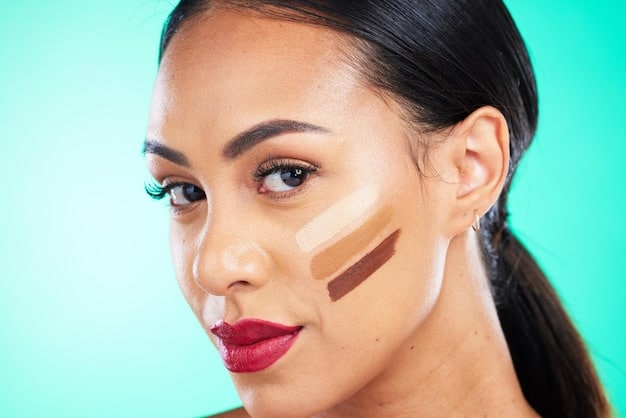Color Correcting: Your 6-Step Guide to Flawless Skin

Advertisements
Color correcting is a makeup technique that uses specific colors to neutralize unwanted tones in the skin, such as redness, dark circles, or sallowness, creating a more even and flawless base for makeup application in six simple steps.
Advertisements
Unlock the secrets to a flawless complexion with color correcting, a technique used by makeup artists to neutralize unwanted skin tones. Follow our simple 6-step guide and achieve a more even and radiant base for your makeup.
Understanding the Basics of Color Correcting
Advertisements
Color correcting revolves around the color wheel’s principles. By understanding which colors neutralize each other, you can effectively address various skin concerns.
Let’s delve into the color theory that makes this technique so effective.
The Color Wheel and Its Importance
The color wheel is your best friend when it comes to color correcting. Colors directly opposite each other on the wheel neutralize each other.
Common Color Correctors and Their Uses
Each color has a specific purpose. Knowing these uses will help you choose the right corrector for your skin concerns.
- Green: Neutralizes redness from acne, rosacea, or sunburn.
- Peach/Orange: Corrects dark circles and hyperpigmentation in fair to medium skin tones.
- Yellow: Brightens dullness and corrects mild redness.
- Purple/Lavender: Counteracts sallowness and brightens dull skin tones.
- Blue: Counteracts orange tones.
Understanding the color wheel and each corrector’s purpose will set you up for color-correcting success. It’s about strategically canceling out unwanted tones to create a balanced canvas.
Step 1: Identifying Your Skin Concerns
Before diving into the application, it’s crucial to identify the specific skin issues you want to address. Accurate identification ensures you’re using the right correctors.
This involves closely examining your skin in natural light.
Redness (Acne, Rosacea, Sunburn)
Redness can stem from various factors, including acne, rosacea, or sunburn. Determine the source and severity of the redness.
Dark Circles and Hyperpigmentation
Dark circles can appear blue, purple, or brown. Hyperpigmentation includes sunspots and melasma.
Dullness and Sallowness
Dullness and sallowness can make your skin look tired. Sallowness often presents as a yellow or greenish undertone.

By accurately identifying your skin concerns, you can select the appropriate color correctors and achieve a more even and balanced complexion. This targeted approach is key to effective color correction.
Step 2: Choosing the Right Color Correctors
Selecting the correct color correctors is paramount. Use the color wheel and your identified skin concerns to guide your choices.
Misusing correctors can lead to an uneven skin tone, so precision is key.
Selecting Correctors Based on Skin Tone
Consider your skin tone when choosing correctors. What works for one person might not work for another.
Different Formulations: Creams, Liquids, and Sticks
Color correctors come in various formulations. Choose one that suits your skin type and makeup preferences.
- Creams: Best for dry skin, providing hydration and blendability.
- Liquids: Suitable for all skin types, offering buildable coverage.
- Sticks: Ideal for targeted application and on-the-go touch-ups.
Selecting the right formulation ensures the corrector blends seamlessly with your makeup, providing a natural and flawless finish. Consider your skin type and the areas you need to correct to make the best choice.
Step 3: Preparing Your Skin
Proper skin preparation is essential for a smooth and long-lasting makeup application. Start with a clean and moisturized base.
This step ensures that the color correctors and subsequent makeup layers adhere properly and look their best.
Cleansing and Moisturizing
Begin with a gentle cleanser to remove any dirt, oil, or makeup residue. Follow up with a moisturizer suitable for your skin type.
Applying Primer
A primer creates a smooth canvas for makeup application, helping to even out skin texture and prolong wear.
- For dry skin: Use a hydrating primer to add moisture.
- For oily skin: Choose a mattifying primer to control shine.
- For sensitive skin: Opt for a fragrance-free and hypoallergenic primer.
Preparing your skin thoroughly ensures that your color correctors and makeup blend seamlessly, resulting in a flawless and natural-looking finish. A well-prepped base is the foundation for any successful makeup application.
Step 4: Applying Color Correctors
With your skin prepped and your correctors chosen, it’s time for application. Use a light hand and build coverage gradually.
Precision is key to achieving a natural and even complexion.
Techniques for Different Correctors
Each color corrector requires a specific application technique. Here’s a breakdown:
* Green: Apply directly to red areas using a small brush or your fingertip. Gently tap and blend the edges.
* Peach/Orange: Use a small brush or sponge to apply under the eyes, focusing on the darkest areas. Blend well.
* Yellow: Apply to areas with mild redness or dullness using a brush or sponge. Blend thoroughly.
* Purple/Lavender: Apply to areas with sallowness using a brush or sponge. Blend well.
Blending and Layering
Blending is crucial for a natural look. Use a damp sponge or brush to gently blend the edges of the corrector into your skin.

Applying color correctors with precision and blending them seamlessly will ensure that your makeup looks natural and flawless. Remember to build coverage gradually and blend thoroughly for best results.
Step 5: Applying Foundation and Concealer
After color correcting, it’s time to apply foundation and concealer. Use a light to medium coverage foundation to avoid masking the corrections.
This step evens out your skin tone and provides a flawless base for the rest of your makeup.
Choosing the Right Foundation
Select a foundation that matches your skin tone and type. Consider the finish you want to achieve – dewy, matte, or natural.
Applying Concealer
Use a concealer that matches your skin tone to cover any remaining imperfections. Apply to areas that need extra coverage, such as blemishes or dark circles.
- Apply concealer in a triangular shape under the eyes to brighten the area.
- Use a small brush to spot-conceal blemishes.
- Blend the concealer seamlessly into your foundation.
Applying foundation and concealer correctly will result in a smooth, even skin tone that enhances your color corrections. Choose the right products and techniques to achieve a flawless base for your makeup.
Step 6: Setting Your Makeup
Setting your makeup is the final step in achieving a long-lasting and flawless look. Use a setting powder or spray to lock everything in place.
This step prevents creasing, smudging, and fading throughout the day.
Using Setting Powder
Setting powder helps to absorb excess oil and keep your makeup in place. Use a large, fluffy brush to apply a light layer of powder to your face.
Using Setting Spray
Setting spray provides a lightweight and refreshing way to lock in your makeup. Hold the bottle about 8-10 inches from your face and spray in a circular motion.
Setting your makeup is the key to a long-lasting and flawless finish. Whether you prefer setting powder or spray, this final step ensures that your makeup stays put and looks fresh all day.
| Key Point | Brief Description |
|---|---|
| 🟢 Neutralize Redness | Use green corrector on acne, rosacea, or sunburn. |
| 🟠 Correct Dark Circles | Apply peach/orange corrector under the eyes. |
| 💜 Brighten Dull Skin | Use purple/lilac to counteract sallowness. |
| 🟡 Even Skin Tone | Apply foundation and concealer after correcting. |
Frequently Asked Questions
▼
Color correcting involves using specific colors to neutralize unwanted tones in the skin. It employs the color wheel to cancel out discoloration, resulting in a balanced canvas for makeup.
▼
Green is the best color for correcting redness. Applying a green color corrector to areas with redness, such as acne or rosacea, can help to neutralize the color.
▼
For fair to light skin tones, peach correctors work best, while orange correctors are more suitable for medium to deep skin tones. Identify the darkness shade and choose correspondingly.
▼
Yes, color correcting can be used on all skin types. Just choose the right formulation (cream, liquid, or stick) that suits your skin. Always prime your skin first to protect it.
▼
Use a damp makeup sponge or brush to gently blend the edges of the corrector into your skin. Apply foundation over the top, using light to medium coverage to avoid masking the corrections.
Conclusion
Mastering color correcting can transform your makeup routine, giving you a flawless and radiant complexion. By understanding the color wheel and following our 6-step tutorial, you can confidently tackle any skin concern and achieve a perfect base for your makeup.





